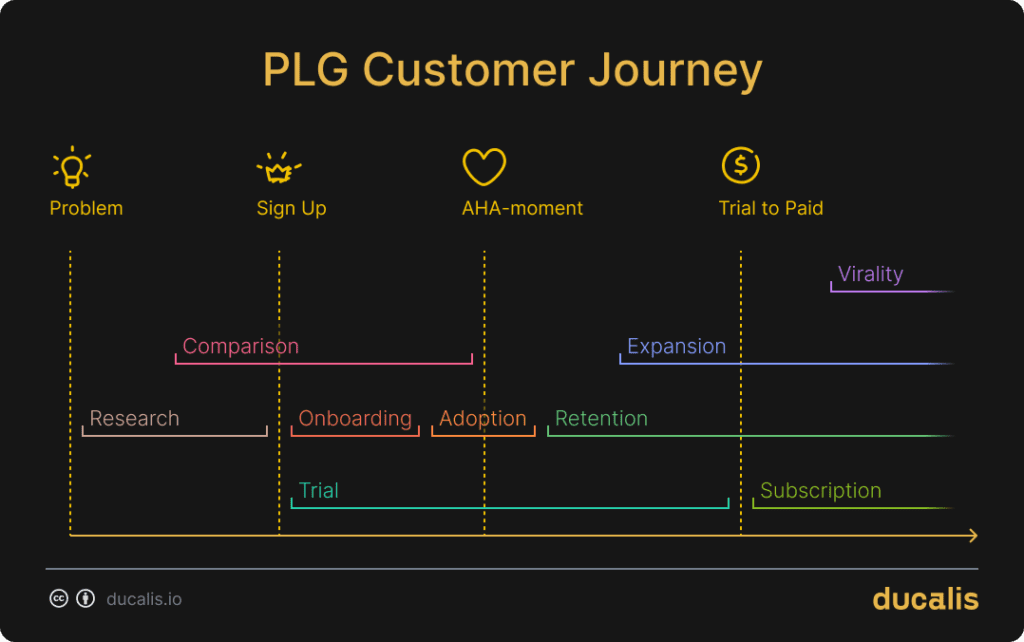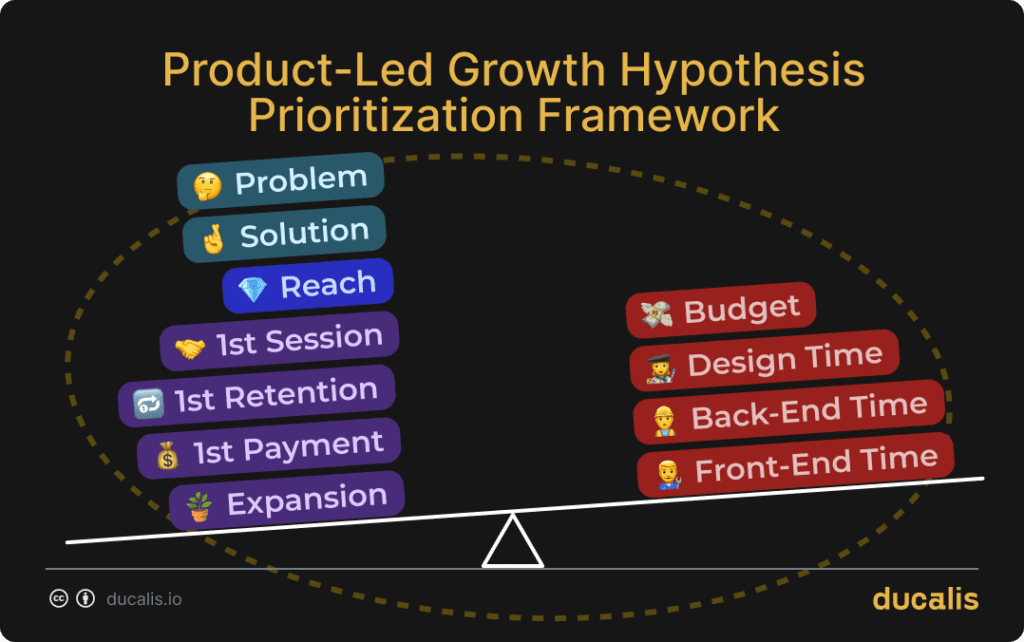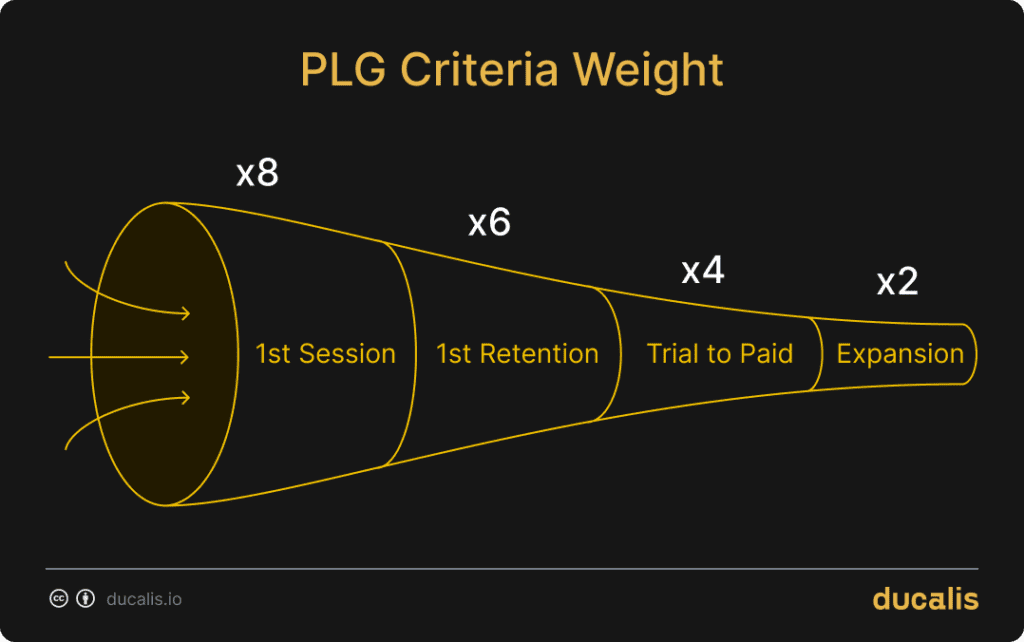Speed up your Product-Led Growth (PLG) with this prioritization framework. It helps build a solid growth engine for B2B software companies faster, using fewer resources. The framework focuses on improving the self-service customer experience by helping newly signed-up users understand the value of your product and stick with it as paying customers.
We have so many attractive and fascinating growth hypnosis, and only ruthless prioritization can determine the MOST IMPACTFUL on YOUR METRICS for YOUR PRODUCT.
In this article, we cover how to build a growth team’s ritual for:
- collecting hypotheses,
- designing the best prioritization framework for your product metrics,
- running a team evaluation from the business, confidence, and technical sides,
- and deciding which bet will work best precisely for your product.
This prioritization framework is a game-changer for B2B software companies looking to speed up their Product-Led Growth.
And the best part? This approach saves up to 90% of the time spent discussing what to try next, resulting in faster PLG motion and greater output.
with Product-Led Growth Hypothesis Prioritization Framework.
What is Product Led Growth (PLG)?

Product-Led Growth (PLG) is a business model focusing on the product experience as the primary driver of customer acquisition and retention. PLG companies are always open 24/7, and growth isn’t constrained by how quickly a company can hire sales reps. This approach is efficient for businesses with a self-service customer experience, such as software-as-a-service (SaaS) companies.
One of the main advantages of implementing a PLG strategy is that it can significantly reduce customer acquisition costs by increasing the capacity and level of automation of new user onboarding.
Why is so much buzz about PLG?
The traditional marketing and sales approach relies on outbound efforts to generate and nurture leads through a sales funnel. However, PLG flips this model on its head by focusing on the product experience as the primary driver of customer acquisition and retention.
The PLG strategy significantly reduces customer acquisition costs. By providing a delightful product experience, users are more likely to share their positive experiences with others, resulting in organic growth.
💡 The product itself becomes the leading marketing and sales channel.
Overall, PLG (product-led growth) has succeeded in driving growth and increasing revenue for many B2B companies, such as Slack, Hubspot, Calendly, Airtable, and Notion.
I highly recommend subscribing to Kyle Poyar’s Substack “Growth Unleashed.” This is one of the best PLG resources nowadays.
Designing PLG Prioritization Framework: Main Areas

To select the most impactful hypothesis, it’s always a good idea to visualize the customer journey and understand where our users may take the wrong turn.
I prefer to name four milestones for nurturing interest in your solution: Problem → Sign Up → Aha-moment → Trial to Paid.
- Problem
It all starts with something itching in your potential customer’s business. They may be Googling some solutions, attending events, and reading blogs on topics around your product field. To catch their attention, you should have good content: landing pages, SEO-optimized articles, templates, Jobs-to-be-done examples, educational content, and convincing case studies. As a result, your product will be shortlisted across competitors. - Sign Up
Your product has less than 15 minutes to grab the user’s attention, personalize the onboarding experience, and convince them that your solution fits their problem best. During the first moments with your product, communication should shorten learning how to use it to achieve the expected outcome—the “AHA moment.” - AHA-moment
The first session is the hardest. But when a user has the motivation to return to your product, you should keep the momentum. Providing more value each session and explaining the benefits of the network effect should lead to expansion. - Trial to Paid
The user is satisfied with the solution. Is there a precise value? Does the price fit the outcome? Are they on a budget? Are there any security concerns? There are many things to consider for the purchase decision.
This provides a simplified yet descriptive overview of the main hypothesis buckets you should choose from for impactful product-led growth.
What is Aha-moment?
The Aha moment is when someone suddenly realizes how useful a product is and why they need it. This moment is crucial because it excites people and wants to keep using the product. Ideally, the Aha moment should happen the first time someone tries a product, usually when they sign up.
What is Product Adoption?
Product adoption refers to people beginning to use your product to achieve their goals after learning about it. The purpose of adoption is to turn visitors into users. The better your adoption rate, the faster and easier users will achieve the Aha moment with your product.
Designing PLG Prioritization Framework: Criteria

The most effective customized prioritization framework should align with your goals and the available resources to achieve them.
Three pillar ideas behind PLG help us achieve our goals.
- Drive adoption and retention
Assist users in realizing the product’s value during their first session without needing external assistance. Otherwise, users may abandon the product and not return it. - Self-service payment
Your product should give users apparent value and a positive return on investment. This will encourage them to subscribe and use your self-service payment billing system. - Land and expand
Once new users sign up and understand your product’s value, they should begin to see its value for their team and be motivated to invite more users.
This leads us to four flag criteria that describe which part of the user’s PLG journey they impact:
- 1st Session
- 1st Retention
- Trial to Paid
- Expansion
Validation and confidence
Working with hypotheses should encourage us to be critical of every idea in the backlog. This requires aligning the hypothesis validation level with the level of confidence in the proposed solution.
- Problem validation
- Solution confidence
Audience leverage
Not all hypotheses have an impact on all users. If your product has multiple user roles, some may have restricted permissions, affecting product adoption. Additionally, if there are numerous product use cases, not all features may be noticed by users. The audience estimation criterion helps to determine how the hypothesis affects different user segments.
- Reach
Resources
Those criteria help to estimate the resources needed for testing the hypothesis. Estimate direct money spending and the team’s effort on the hypothesis implementation.
- Front-End Time
- Back-End Time
- Design Time
- Budget
The structure of the Product-Leg Growth prioritization framework
Below is a detailed description of each framework’s criteria and evaluation scale.
👉 Create a Ducalis prioritization board in just one click with all settings applied.
1st Session
Increases the chances of understanding the product’s core value during the first session.
0 – Does not apply to the first session
1 – Can be done in the first session, but not necessary
2 – Must be done in the first session. Otherwise, we lose a new user
1st Retention
Encourages returning to the product for the first time
0 – Not at all
1 – Average, may return some users
2 – Specifically aimed at the first return
Trial to Paid
How close does it bring to the first payment?
0: Not at all
1: Moderately, the idea may lead to reviewing the payment schedule in the first session 2: Directly affect payment and billing
Expansion
Most new users sit alone in their accounts. How many users can this invite?
👇 Edit values according to your product goal
0: No impact
2: 1+ user
4: 4-8+ users
8: 10+ users
Reach
How many new users will be affected by this within a week?
👇 Edit values according to your product goal
1: No data at all
2: A few
3: Dozens
5: A couple of dozens
8: Half
13: All admins
21: All admins + invited
Problem
Validity/prevalence of the problem of hypothesis.
1: It is not known to have caused any inconvenience to anyone
2: There have been isolated cases a long time ago
3: There have been some problems recently
5: Regularly, someone is having trouble with this
8: There is a 50/50 chance. That such a problem exists
13: The problem exists, but the numbers are not very significant
21: There is a firm and apparent significant problem that exists
Solution
Confidence that the proposed hypothesis will solve the problem?
1: No idea
2: Believe the chance is low
3: Intuition tells me to try
5: Others have successful cases
8: We tried before, but no results, but I still believe
13: Tried before, results were better than bad
21: We did something similar before, and there were good results
Front Time
Time Estimations for Front-End Development.
👇 Edit values according to your dev cycle
1: No effort is required.
2: Half a day or less.
3: One day.
5: Two days to half a sprint.
8: Four to five days, or one sprint.
13: More than one sprint but less than two.
21: Two sprints or more.
Back Time
Time estimates for back-end development:
👇 Edit values according to your dev cycle
1: No effort is required
2: Half a day or less
3: One day
5: Two days to half a sprint
8: Four to five days or one sprint
13: More than one sprint but less than two sprints
21: Two sprints or more
Design Time
Time estimates for designing the hypothesis:
👇 Edit values according to your design cycle
1: No effort is required
2: Half a day or less
3: One day
5: Two days to half a sprint
8: Four to five days or one sprint
13: More than one sprint but less than two sprints
21: Two sprints or more
Budget
Should we spend money on hypothesis testing?
👇 Edit the values according to your spending range.
1: Free
2: < $100
3: $100+
5: $500+
8: $1,000+
13: $2,000+
21: $5,000+
Team prioritization + PLG = Faster Testing
The simple yet powerful workflow saves Ducalis users about 90% on calls and discussions for estimations. This ensures that your backlog is up-to-date and that you can rely on your estimates.
The greater the uncertainty in your estimates, the more helpful problem perspectives can be in choosing the next item for your growth hypothesis testing.
- Diverse opinions
Assign teammates to each criterion. - Create a prioritization routine
Establish a weekly or bi-weekly cycle for discussing your hypotheses during Sprint Planning. - Reduce bias
Enable an evaluation poker mode until the reveal moment. During this period, each teammate will not be able to see the estimations of others.
Use Ducalis’ team collaborative prioritization by inviting your teammates for the evaluation.
5 Tips on how to apply Growth Hypothesis framework for your team
Remember the rule —The best prioritization framework reflects your company goals and team structure.
1. Sync with your current task tracker’s backlog
Do you have an existing growth hypothesis backlog? Merge it with the list from that template.
Connect Jira Cloud, Jira Server, Asana, Trello, Linear, Clickup, Github, and Youtrack to pull and push existing ideas for prioritization at Ducalis. It just takes 2 minutes.
2. Add, remove, and edit criteria or descriptions
The most effective prioritization framework aligns with your goals, metrics, strategy, and team structure.
Remove unnecessary elements and add anything missing, including time frames, budgets, and names. Be as specific as possible while editing criteria.
3. Balance Criteria Weights
After the first prioritization session, some hypnoses will go higher in the Backlog section. The current framework’s criteria are balanced so that the backlog item with a more significant influence on the beginning of your PLG funnel will get a higher ranking.

By editing the Weight property for criteria, you can manage what to focus on more.
For example, if you want to shift your effort towards retention, you can decrease the first session’s weight and increase the first retention’s weight (importance).
If you want to treat all areas equally, you’re right — use the same weight for each criterion.
4. Keep Priorities Up to Date
Some hypotheses may remain in your backlog for extended periods, posing a risk of skewed priorities that may deteriorate over time as your product evolves.
Enable the Score Expiration feature to reset your evaluations periodically (6-9 sprints are recommended).
And keep your Team Alignment across your entire team:
5. Capture growth ideas across the entire company
Create a voting board to capture your teammates’ ideas and add them instantly to the evaluation. Also, share your plan for the current state of growth experiments and communicate your results with the entire company.
with Product-Led Growth Hypothesis Prioritization Framework
